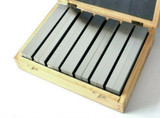New Touch Probe. Which type do I need? Infrared or Radio Transmission?
Posted by Jonathan Gee, EMG Precision on Sep 20, 2021
New Touch Probe. Should I choose an Infrared or Radio Transmission CNC Probe?
The EMG Taculus Series currently offers a choice of two wireless CNC machine touch probes. This article will help you decide the pro's and con's of either option to help you decide which is the right choice for your requirements. If you are looking for a new probe and want some help to understand what the differences are and whether you should choose a new touch probe with infrared or radio transmission. Your questions are answered below with our clear outline for which type of probe would suit your application.
Preface
EMG Precision machine tool probes are designed for use on machining centres, milling, boring and drilling centres and B-axis automatic tool change lathes. Our EMG probe models, the R2i and the IFi-P4 are industrial precision and performance pieces of equipment designed to perform very precise inspection and measurement functions. They are also commonly used for aligning workpieces, tool setting, cutter wear detection and compensation and tool breakage.
Wireless probe solutions are critical for high functioning, high performing machine shops to maximise their productivity and improve the quality and accuracy of the components manufactured. We will discuss productivity and quality improvements as a result of using wireless probes in another article.
What Types of CNC Touch Probe are there?
Currently, at the time of writing this post EMG Precision offer two types of wireless machine tool probe. The first entry to the Taculus range is the IFi-P4 Infrared Wireless Machine Probe and the R2i Radio Wireless CNC Touch Probe. Both solutions principally offer the same functionality but the technology that is used for communication differs significantly. In order to translate a probe trigger signal into a coordinate measurement or work offset value a signal must be sent by the probe and received by the CNC machines computer controller.
Available Technologies...
Infrared
Radio
What are the Key Features of each CNC Probe Technology?
Below is a summary of the key features that are specific to each of the two CNC Touch Probe technologies discussed. We discuss their most fitting applications, the different benefits and limitations of each type in order to help you decide which type of solution best suits your application.
Key Infrared Features
- Generally speaking a direct line of sight is required between Probe and Receiver.
- Line of sight can be reflected off certain surfaces but it is unstable and should not be relied on.
- Infrared probe versions are generally cheaper to manufacture than alternatives so they are likely more affordable to the end user.
- No Licenses required.
- Infrared is not susceptible to interference from electrical devices.
- If required, shielding from infrared is relatively easy.
Key Radio Probe Features
- A line of sight is not required for effective communication.
- Radio signal transmission can bend round corners or enter covered areas like deep cavities or bores.
- Typically the most costly option.
- Use licenses can be required for certain frequencies, but our EMG Precision Probes operate within license-free frequency bands.
- Radio can be susceptible to interference from electrical devices.
- If the locality or application require shielding from the radio transmissions, this can prove more difficult to achieve than with infrared.
There are of course a myriad of other features or pro's and con's of each of these two communication technologies. We have limited the list to characteristics and traits that are most likely linked to the use of probes in professional, machine shop environments.
In conclusion, the decision rests on variables that are most commonly linked to the size, design, locality and environment in which the probe is likely to operate in. Generally speaking though, if you believe that a constant line of site is achievable from our probe receiver to the probe itself, then the IFi0-P4 Infrared option is most likely the best option for yourself. If for example your probe and receiver operate in an environment whereby direct line of sight (LOS) is not always going to be the case, we would advise to choose the Radio R2i EMG Probe for more stability. An example of this maybe on a 5-axis machine whereby the movement of the base and stock could hinder or block a LOS. Regular probing cycles in deep cavities or bores or complex clamping assemblies may also cause communication issues when using an infrared probe. Another example could be that your probe is mounted in a giant tool carousel that prevents direct line of sight.
Below you will see a bullet-point clarification of the key situations where each technology would be more suited...
In summary
The points below will make it easier for you to choose which technology is most appropriate for your inspection or machine shop application. Need a new Touch Probe? Infrared or Radio Transmission? Use the checklist below to see which technology suits your needs better.
Infrared Transmission Technology
- Generally ideal for 3-axis machines.
- Line of sight is likely to remain un-interrupted..
- Unusual application means signal shielding is required.
- Up to 5 metre range.
Radio Transmission Technology
- Best for 5-axis machines
- Does not require 'Line of Sight' (LOS)
- Application requires no signal shielding.
- Up to 15 metre range.
- Allows more options for future use on more complex applications.
"The TACULUS Series of Tool Probes represent a level of afforable, industrial quality and reliable ultra-precision, previously unheard of in this budget range. "
Thank you for taking the time to read this article. One of our customers made this exact enquiry so we thought it worthwhile to write a piece on this subject. If there is anything else you would like to see discussed on our website, please let us know through our Contact Form or email us at info@emgprecision.com and we will happily consider covering the topic in one way or another
SUBSCRIBE TO OUR NEWSLETTER
Recieve our latest weekly releases, offers, guides and more.










 GBP
GBP US Dollar
US Dollar
 Euro
Euro
 Norwegian Krone
Norwegian Krone
 Canadian Dollar
Canadian Dollar
 Bulgarian Lev
Bulgarian Lev
 Polish Zloty
Polish Zloty
 United Arab Emirates Dirham
United Arab Emirates Dirham
 Australian Dollar
Australian Dollar
 Swiss Franc
Swiss Franc
 New Zealand Dollar
New Zealand Dollar
 Russian Ruble
Russian Ruble


